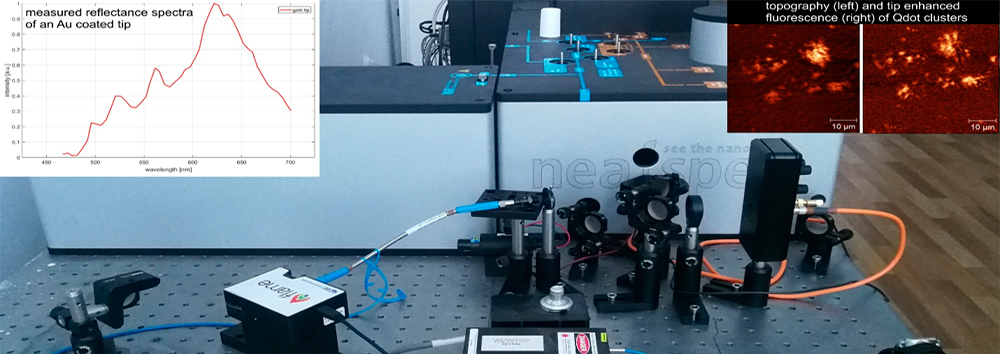©TEFPLASNOM
What has the ATTRACT seed funding enabled you to do so far?
The TEFPLASNOM project leverages the synergy and skills of two partner teams with expertise in far-field and near-field optical microscopy (Politehnica University Bucharest) and advanced materials (University of Perugia), to demonstrate a new version of tip-enhanced fluorescence microscopy that exceeds current ones in terms of sensitivity. In this endeavour we have designed a set of protocols for fabricating various types of nanostructured materials (e.g. fluorophore doped silica nanoparticles, fluorescent quantum dots, etc.) that can serve as support for performing proof-of-concept studies on super-resolved fluorescence. On the instrumentation side, a commercial system for scattering-type scanning near-field optical (s-SNOM) microscopy in IR was custom modified to incorporate an additional channel/module that allows performing tip-enhanced fluorescence studies, based on conventional and plasmon resonance related approaches. This setup allows both imaging and spectroscopic assays, as it incorporates both a lock-in coupled detector for imaging tip-enhanced fluorescence and a spectrometer, which allows to spectrally resolve the optical signals of interest (E.g. related to the probe, sample or substrate). This developed module serves as a platform for implementing various proof-of-concept experiments based on tip-enhanced fluorescence, and its versatile design, allows exciting the samples of interest with discrete illumination wavelengths in the range of 450-700nm, by means of a supercontinuum laser source coupled to an acusto optical tunable filter (or with broadband emission in the range of 450-2400nm, by removing the AOTF). The current configuration can also be used to harness in tandem the power of two complementary optical techniques for nanoscale imaging, tip-enhanced fluorescence and s-SNOM. This possibility is further augmented by atomic force microscopy, intrinsically available in this setup, which is extremely valuable for placing optical data into a well understood topographic context. The combination of these techniques can resolve subtle properties of both biological specimens and advanced materials, unavailable to a single technique. Also important, TEFPLASNOM provided the perfect premises for the two partners to become better acquainted with the skills of each other, which has led to opening up new joint research avenues that will be exploited beyond this project.
What challenges have you faced so far?
To demonstrate the imaging technique proposed in TEFPLASNOM (carrying the same name as the project) we first planned to modify a home-made prototype imaging system that UPB has previously developed, in particular its module for Apertureless Scanning Near-Field Optical Microscopy (ASNOM). After some initial efforts spent in this regard, we have re-designed our strategy to demonstrate the TEFPLASNOM technique, and decided to switch to an alternative ASNOM system available in UPB’s labs to serve as an underlying development platform, namely a commercial NeaSNOM (NeaSpec, Germany) system. Transferring our project related optical setup to this alternative development platform has been successfully completed, but at the expense of some unforeseen provisions of time. Other technical challenges refer to the modulation of the optical signals of interest which is required in imaging techniques that rely on tip-enhancement effects. Typically, such modulation is achieved by means of a tapping tip which oscillates vertically on top of the object of interest. By means of a lock-in amplifier, the optical signal influenced by the tip (thus spatially resolved at the tip’s dimension), is extracted from the background. The TEFPLASNOM technique requires illuminating a cantilever’s tip with a specific wavelength that matches the absorption band of plasmonically active material coating the tip (E.g. gold, platinum). For this, we use an illumination ensemble consisting of a supercontinuum laser coupled to an acusto optical filter, but typically supercontinuum sources are pulsed, and this second modulation of the optical signal of interest adds additional complexity to the problem of extracting the optical signals of interest by lock-in amplification. Finally, additional challenges that we faced were related to the lead times of components & materials, and the transfer times associated to the shipment of synthesised materials from UNIPG to UPB.
Where does your ATTRACT journey go from here?
UPB’s team for this project has strong ties with companies that develop and commercialise high-end system for near-field imaging and also with companies developing probes (tips) for various Scanning Probe Microscopy Techniques and applications. The two partners intend to collaborate with these companies to take the developed technique and proof-of-concept materials, at higher TRL, and eventually to the market. Such efforts will require either funding from the industry partners interested to develop joint intellectual properties, and expand their portfolio of products, or identifying new funding opportunities to support collaborative research at EU level. To this end, they commend the initiative of the Attract consortium to obtain funding to potentially implement a second phase of this framework, which would allow cutting edge technologies developed in Phase-1 to be further developed at higher TRL. With respect to our project, we believe that taking the technologies/methods developed here at higher TRL will accommodate the launch of successful spin-offs in the areas of (i) near-field imaging systems, (ii) contrast agents using fluorescence and plasmonics and (iii) scanning probes (tips). The two partners, UPB and UNIPG are set on taking full advantage of these opportunities and plan to consistently collaborate beyond this project.
Sum up in two sentences the advantages of the ATTRACT Programme over other research funding schemes.
The ATTRACT projects didn’t have to bear the typical reporting requirements of EU funded projects. Light-reporting requirements allowed us to focus our efforts on actual R&D activities. Furthermore, flexibility on the implementation period was important for us as it allowed to compensate the effects of the unforeseen situation described at point b). Finally, we find very important the ATTRACT Phase-2 incentive, which stimulates ongoing ATTRACT projects implementing complementary research to be in contact with each other, to identify valuable synergies and potential collaboration avenues and opportunities.
For more information
Visit the TEFPLASNOM project site.


